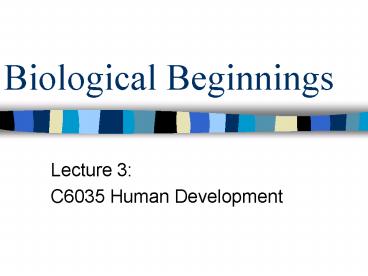Biological Beginnings - PowerPoint PPT Presentation
1 / 28
Title:
Biological Beginnings
Description:
Fraternal Twins dizygotic, twins develop from a separate sperm and separate egg. Identical Twins monozygotic, twins develop from single fertilized egg that ... – PowerPoint PPT presentation
Number of Views:159
Avg rating:3.0/5.0
Title: Biological Beginnings
1
Biological Beginnings
- Lecture 3
- C6035 Human Development
2
Evolutionary Perspective Natural Selection
Adaptive Behavior
- Natural selection is evolutionary process
favoring individuals of a species best adapted to
survive reproduce - Adaptive behavior promotes organisms survival in
natural habitat
3
Race and Ethnicity
- Race is a biological concept referring to a
system for classification of plants animals
according to physical structural
characteristics - Ethnicity is a sociocultural concept reflecting
religion, heritage language
4
Heredity and Reproduction
- Genes are a blueprint for cells to reproduce
themselves manufacture proteins that maintain
life - Chromosomes - Comprises content of living cells
in 23 pairs of threadlike structures - DNA - A molecule containing genetic information
in shape of a double helix which make up genes
5
Reproduction
- Process by which an organism transmits
characteristics from one generation to next - Gametes reproductive cells created in testes of
male and ovaries of female - Meiosis process of cell doubling separation of
chromosomes - Reproduction process that begins when female
gamete is fertilized by male gamete - Zygote formed through fertilization process.
6
(No Transcript)
7
(No Transcript)
8
(No Transcript)
9
(No Transcript)
10
(No Transcript)
11
(No Transcript)
12
Abnormalities in Genes and Chromosomes
- Phenylketonuria (PKU) genetic disorder where
individual cannot metabolize amino acid can
result in mental retardation hyperactivity - Down Syndrome genetically transmitted form of
mental retardation caused by presence of an extra
(47th) chromosome - Sickle-cell Anemia occurs mostly in people of
African descent affecting red blood cells.
13
Abnormalities in Genes and Chromosomes
- Klinefelter Syndrome in which males have an extra
X chromosome to form XXY instead of XY - Turner Syndrome in which females are missing an X
chromosome to form XO instead of XX. - XYY Syndrome where males have an extra Y
chromosome was once believed to be cause of
violence in men who possessed XYY composition.
Abnormalities in Genes and Chromosomes, modern
research dispelled this belief
14
Prenatal Procedure Tests To Determine
Abnormalities
- Amniocentesis amniotic fluid drawn by syringe
tested for chromosomal or metabolic disorders - Ultrasound Sonography using high-frequency sound
waves to attain visual representation of fetus
inner structures. - Chorionic Villus Test small sample of placenta
removed to determine whether or not abortion is
safe near end of first trimester - Maternal Blood Test diagnostic technique to
assess blood alpha protein levels associated with
neural-tube defects
15
(No Transcript)
16
Genetic Principles, Methods Influences
- General Principles Dominant-recessive Genes
Principle - is higher influence of the dominant
gene over the recessive except where recessive is
present in two genes of a pair
17
(No Transcript)
18
- Polygenic Inheritance influence of many genes
interacting to produce particular characteristic - Genotype persons genetic heritage, actual
genetic material - Phenotype way an individuals genotype is
expressed in observable measurable
characteristics - Reaction Range range of possible phenotypes for
each genotype which demonstrates importance of
environment - Canalization developmental course taken by
certain characteristics presumably as protection
for reaction to environment
19
(No Transcript)
20
(No Transcript)
21
(No Transcript)
22
(No Transcript)
23
Methods Used By Behavior Geneticists
- Behavior Genetics study of degree nature of
behaviors hereditary basis - Twin Study behavioral similarity of identical
twins is compared with that of fraternal twins - Fraternal Twins dizygotic, twins develop from a
separate sperm and separate egg - Identical Twins monozygotic, twins develop from
single fertilized egg that splits into two
genetically identical replicas - Adoption Study compare development of adopted
children with that of biologically reared
children to note differences between nature
nurture
24
Hereditys Influence on Development
- Study of hereditys influence on development
generally centers around intelligence
temperament of an individual studying impact of
genetics on intelligence has produced most
controversy - Arthur Jensen claims that culture environment
have minimal effect on intelligence - Murry and Hernsteins bell curve theory predicts
growth of an underclass of intellectually
deprived individuals
25
(No Transcript)
26
Heredity-Environment Interaction
-Genotype-Environment Concepts
- Behavior geneticists believe that heredity
environment interact - Passive Genotype-Environment Interactions occur
when parents who are genetically related to child
provide a rearing environment for child - Evocative Genotype-Environment Interactions occur
because childs genotype elicits certain types of
physical social environments - Active (niche-picking) Genotype-Environment
Interactions occur when children seek out
environments compatible stimulating
27
Shared and Nonshared-Environment Influences
- Some theorists believe that environments role in
heredity-environment interaction can be carved up
to consider experiences of children that are in
common with those of other children living in the
same home, as well as experiences that are not
shared - Shared Environmental Influences childrens common
experiences such as their parents personalities
intellectual orientation. - Nonshared Environmental Influences childs unique
experiences that are not shared with another
sibling.
28
Nature and nurture operate together
- They cooperate - to produce a persons
intelligence, temperament, height, weight,
ability to pitch a baseball, reading skills, etc - Conclusions About Heredity-Environment Interaction

